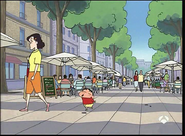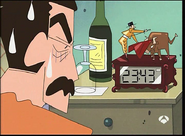Tag: Source edit |
No edit summary Tag: Source edit |
||
| (3 intermediate revisions by 3 users not shown) | |||
| Line 18: | Line 18: | ||
==Crayon Shin-chan in Spain== |
==Crayon Shin-chan in Spain== |
||
| − | Crayon Shin-chan was first aired in Spain in April 2000 (under the name Shin Chan), with licensed by LUK Internacional, who already licensed ''Doraemon'' for Spain in 1990s. TV3, an autonomic Catalan TV channel was the first broadcaster of Shin Chan, followed by autonomic Basque, Galician and Valencian channels. It wasn't until the end of 2000 when Shin Chan was first dubbed |
+ | Crayon Shin-chan was first aired in Spain in April 2000 (under the name Shin Chan), with licensed by LUK Internacional, who already licensed ''Doraemon'' for Spain in 1990s. TV3, an autonomic Catalan TV channel was the first broadcaster of Shin Chan, followed by autonomic Basque, Galician and Valencian channels. It wasn't dubbed in Spanish until at the end of 2000 when Shin Chan was first dubbed in that language and aired on Cartoon Network Spain. |
Over the following years, the series grew in popularity, 2003 was a milestone when the movie [[Crayon Shin-chan: Pursuit of the Balls of Darkness]] was released in theaters. Until the summer of 2005, Shin Chan continued being broadcasted both autonomically in different languages and nationally in Spanish. At the same time, it received several bad reviews from different associations, leading to some censorship in certain episodes (mainly with the language and expressions). |
Over the following years, the series grew in popularity, 2003 was a milestone when the movie [[Crayon Shin-chan: Pursuit of the Balls of Darkness]] was released in theaters. Until the summer of 2005, Shin Chan continued being broadcasted both autonomically in different languages and nationally in Spanish. At the same time, it received several bad reviews from different associations, leading to some censorship in certain episodes (mainly with the language and expressions). |
||
| Line 24: | Line 24: | ||
In 2005, Antena 3 (one of the main national TV broadcasters in Spain) bought the emission rights of the series, stopping the autonomical emissions (that aired until episode 371). The popularity kept growing until 2007 when another movie reached the cinemas, [[Crayon Shin-chan: The Storm Called: The Adult Empire Strikes Back]]. |
In 2005, Antena 3 (one of the main national TV broadcasters in Spain) bought the emission rights of the series, stopping the autonomical emissions (that aired until episode 371). The popularity kept growing until 2007 when another movie reached the cinemas, [[Crayon Shin-chan: The Storm Called: The Adult Empire Strikes Back]]. |
||
| − | After 2008 the series suffered a great decline in popularity, due to constant broadcasting of old episodes. The frequency of emissions decreased until today (a few emissions mainly in the morning), with a small bunch of new episodes translated every year. |
+ | After 2008, the series suffered a great decline in popularity, due to constant broadcasting of old episodes. The frequency of emissions decreased until today (a few emissions mainly in the morning), with a small bunch of new episodes translated every year. |
Despite its success or not, some channels moved the series to night programming or dropped it completely after complaints by parents associations who claimed it was not appropriate for children. |
Despite its success or not, some channels moved the series to night programming or dropped it completely after complaints by parents associations who claimed it was not appropriate for children. |
||
| − | Spain has been the country outside Japan where Crayon Shin-chan achieved the greatest popularity. A proof of that is the fact that several video games or other merchandising were only available in these two countries. As of October 2019 over 800 episodes including specials have been dubbed in Spanish and aired in Spain and concurrently it is airing on the Spanish version of the |
+ | Spain has been the country outside Japan where Crayon Shin-chan achieved the greatest popularity. A proof of that is the fact that several video games or other merchandising were only available in these two countries. As of October 2019 over 800 episodes including specials have been dubbed in Spanish and aired in Spain and concurrently it is airing on the Spanish version of the Star Channel which since March 2024 is the name of the channel formerly known as FOX. |
Currently, the manga series was released up to Japanese volume 25 in Spanish and up to 35 in Catalan. |
Currently, the manga series was released up to Japanese volume 25 in Spanish and up to 35 in Catalan. |
||
| Line 48: | Line 48: | ||
vlcsnap-2013-06-16-18h44m23s115.png|Carmen (the guide) and his family |
vlcsnap-2013-06-16-18h44m23s115.png|Carmen (the guide) and his family |
||
Vlcsnap-2013-11-04-11h14m25s144.png |
Vlcsnap-2013-11-04-11h14m25s144.png |
||
| − | </gallery> |
||
| − | |||
| − | ==Media== |
||
| − | <gallery> |
||
| − | Shinchan - Spanish Opening 1 |
||
| − | Shinchan - Spanish Opening 2 |
||
</gallery> |
</gallery> |
||
Latest revision as of 09:59, 10 April 2024
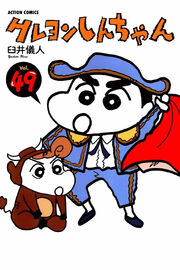
Manga volume 49
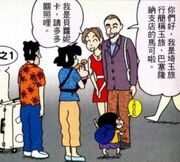
Marc Bernabé and his girlfriend Vero
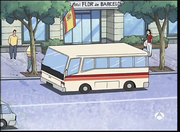
Hotel where the Noharas stayed
Spain is a country in South Europe with almost 50 million inhabitants. It is, besides from Japan, the country were Crayon Shin-chan has experienced the biggest success, with a great quantity of episodes, movies and merchandising translated or imported there.
This fact didn't remain unnoticed to Yoshito Usui, author of the manga, who made the Nohara family visit the country several times, both in the manga and in the anime.
The Nohara family visits Spain
Due to the great popularity of the series in Spain, Yoshito Usui, author of the manga, made the Nohara family visit Spain in the manga in volume 49 (on the cover Shinnosuke appears disguised as a bullfighter).
In this story we see Marc Bernabé, the first translator of Shin-chan to Catalan (and later personal friend of Yoshito Usui), and his girlfriend as main characters. The plot of the story is darker than usual, with a drug dealer accidentally exchanging his bag with Shinnosuke's. This story was brought to the anime some years later, in 2013, episode 816 (スペインでお宝ゲットだゾ).
In an interview in 2003, Marc proposed to Yoshito that Shin-chan visits Spain in the anime. The mangaka agreed to it, and in May 2004 episode 501 (Hola! Our Trip to Spain) aired.
In both cases, the Noharas win a trip to Spain in a lottery, and are received and introduced to the city of Barcelona by local guides. Several emblematic buildings and tourist attractions are shown in the episodes.
In real life, some lucky people won a trip to Japan (organized by the Catalan channel K3), and were able to meet Yoshito Usui himself and visit the publishing facilities which produces Crayon Shin-chan.
Crayon Shin-chan in Spain
Crayon Shin-chan was first aired in Spain in April 2000 (under the name Shin Chan), with licensed by LUK Internacional, who already licensed Doraemon for Spain in 1990s. TV3, an autonomic Catalan TV channel was the first broadcaster of Shin Chan, followed by autonomic Basque, Galician and Valencian channels. It wasn't dubbed in Spanish until at the end of 2000 when Shin Chan was first dubbed in that language and aired on Cartoon Network Spain.
Over the following years, the series grew in popularity, 2003 was a milestone when the movie Crayon Shin-chan: Pursuit of the Balls of Darkness was released in theaters. Until the summer of 2005, Shin Chan continued being broadcasted both autonomically in different languages and nationally in Spanish. At the same time, it received several bad reviews from different associations, leading to some censorship in certain episodes (mainly with the language and expressions).
In 2005, Antena 3 (one of the main national TV broadcasters in Spain) bought the emission rights of the series, stopping the autonomical emissions (that aired until episode 371). The popularity kept growing until 2007 when another movie reached the cinemas, Crayon Shin-chan: The Storm Called: The Adult Empire Strikes Back.
After 2008, the series suffered a great decline in popularity, due to constant broadcasting of old episodes. The frequency of emissions decreased until today (a few emissions mainly in the morning), with a small bunch of new episodes translated every year.
Despite its success or not, some channels moved the series to night programming or dropped it completely after complaints by parents associations who claimed it was not appropriate for children.
Spain has been the country outside Japan where Crayon Shin-chan achieved the greatest popularity. A proof of that is the fact that several video games or other merchandising were only available in these two countries. As of October 2019 over 800 episodes including specials have been dubbed in Spanish and aired in Spain and concurrently it is airing on the Spanish version of the Star Channel which since March 2024 is the name of the channel formerly known as FOX.
Currently, the manga series was released up to Japanese volume 25 in Spanish and up to 35 in Catalan.








